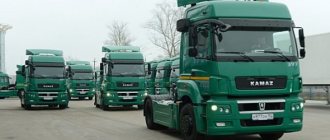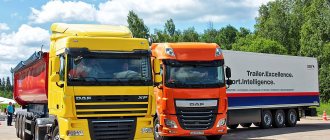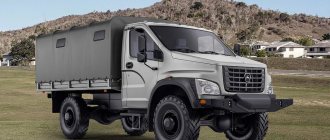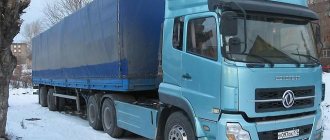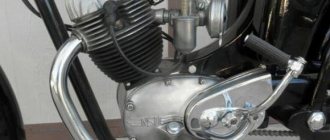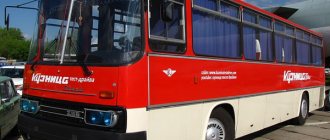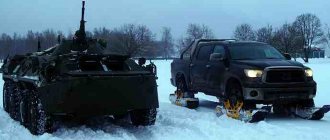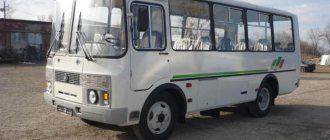Chinese engine, Finnish bridges: test drive of the fastest KamAZ in the world
After accelerating and jumping, the racing KAMAZ is capable of flying several meters and landing softly on all four wheels.
At first glance, there is nothing special here, since this picture takes place every time the KAMAZ-master team goes to the Dakar rally. But if you don't watch it on TV, but find yourself in the cockpit of this racing truck, the sensations will be completely different.
It's a completely different feeling in the cab of a racing truck.
The team and its traditions. The KAMAZ-master team has an excellent tradition of gathering press representatives in the summer and autumn to tell and show how the legendary team lives. A mandatory part of such a program is a 20-minute ride in a sports fireplace (as a racing truck is called) at a special testing ground.
But first it’s worth saying a few words about the team itself. This is not a small garage at all, but an excellent and huge base where cars are built and repaired. Here the frames are made independently, the engines are boosted, which is why the staff of the “motor sports team” is about 200 people.
Therefore, watching the moments when a team from Russia will smash another opponent using foreign-made cars, it is worth keeping in mind that this is the result of painstaking and careful work. Team partners play a significant role in this. The well-known company Total is responsible for all the main points - sports KAMAZ trucks are filled with only oils and fluids recommended by specialists from this company after careful selection.
Car design. The design of combat vehicles deserves a separate story, since it is no secret that there is practically nothing from production vehicles there. This is true, since the company took only the cockpit from the commercial vehicle for installation on the racing ones. But this is normal, since competitors in most cases do the same.
The car ride has become much more comfortable after the improvements made, but the sensation is still exciting.
This is the art of creating designs for multi-ton sports utility vehicles. You are allowed to take any components from any manufacturer, but you must use them to assemble a fast, light and reliable car. The next stage will be setting up the car, and it will be driven by experienced pilots, navigators, and serviced by experienced mechanics.
Now about the components: axles are supplied by the Finnish Sisu, automatic transmissions are supplied by the American Allison, shock absorbers are supplied by the Dutch Reiger. The Chinese-made power plant is DCEC, despite the fact that many people mistakenly call 13-liter engines “Cummins”. They come to the team with a standard configuration of 400 hp, where engineers are already increasing the power to 1000 hp. Lubrication is carried out with correctly selected oil provided by the team’s technical partner, Total.
The car ride has become much more comfortable after the improvements made, but the sensation is still exciting. The car accelerates to 100 km/h on a dirt road in 10 seconds with a manual transmission, with an automatic transmission in 6 seconds. To control you need not only excellent vision, muscles of steel and natural speed, but also a fantastic ability to sense dimensions.
The final part of the trip was a signature trick in the form of acceleration and jumping from a half-meter springboard, during which there is a feeling of hanging in the air.
Conclusion. The final part of the trip was a signature trick in the form of acceleration and jumping from a half-meter springboard, during which there is a feeling of hanging in the air. After landing, while the pilot is parking the car, there is an opportunity to take a breath.
KAMAZ-65807. More powerful, bigger and heavier
Less than a year after the debut of the promising five-axle mining dump truck KAMAZ-65805, the Kama Automobile Plant demonstrated to potential customers an even heavier vehicle, which is larger in weight, power and size. The new vehicle with a 10x6 wheel arrangement received the designation KAMAZ-65807.
At first glance, the new Kama quarryman is outwardly indistinguishable from last year’s debutant. But if you look closely, you can’t help but notice that both its body and track are wider. That is, KAMAZ-65807’s overall width no longer fits into the restrictions for free movement on public roads. Why? The designers took this step, solving two important problems at once.
Firstly, according to one of the developers, the dump truck was equipped with a body that was increased in width to make it easier to load with mining excavators: the previous body was not wide enough for their hefty buckets. As a result, the geometric volume of the dump truck increased from 26 to 30 cubic meters.
Secondly, since the volume of transported cargo has increased, its weight has also increased - it has grown by five tons. And if so, then it was necessary to strengthen the design of the chassis, in particular, to use more lifting axles. Here they were also supplied by SISU, but the permissible load on each of the front ones increased from 11 to 13 tons, on each of the rear ones - from 21 to 23 tons. The track of such bridges is larger; they also make the dump truck wider than the limit for public roads of 2.55 m.
As a result of the above-mentioned changes made to the design of the five-axle truck, with a load capacity of 65 tons, the total weight of KAMAZ-65807 reached 95 tons versus 85 tons for KAMAZ-65805. It is clear that the increase in weight required that the new dump truck be equipped not only with more lifting axles. In particular, it received the most powerful modification of the KAMAZ inline-six, developing not 500, but 550 hp, as well as a frame with additional reinforcement. This frame turned out to be somewhat taller, therefore, in order not to exceed the 4-meter height limit, the developers reluctantly decided to use tires with a smaller radius. But choosing among them those that would confidently hold the required load turned out to be difficult - in order not to overload them, it was even necessary to forcibly limit the speed of a dump truck with a filled body to 40 km/h.
In addition to the differences, the design of the two Kama five-axle mining dump trucks also has similar technical solutions.
One of them is the original mechanism for controlling the wheels of the last, fifth bridge, which rotate together with the bridge itself around a central vertical axis. This solution, of course, simplifies and reduces the cost of the design, but at the same time introduces restrictions on both the maximum maneuvering speed and the angle of rotation of the rear wheels. The speed indicators of the start of the maneuver are monitored by an electronic limiter, and the turning angle is limited to only 6° - this is no longer possible, since the fifth axle is also a drive axle, that is, it is connected to the transmission, being connected to it by a cardan. An interesting point: the rotation of the fifth axle is carried out using two powerful hydraulic cylinders installed along the rear end of the frame.
The second technical solution in the design of the Kama five-axle vehicles, which is worth noting, is the use of hydropneumatic suspension on the three rear axles. In addition to its obvious advantages, such as the ability to maintain constant rigidity and redistribute weight between axles, let’s mention one more thing: using hydraulics, you can level a dump truck on a transverse slope - this is important when unloading, since along with the rise of the body, the center of mass also rises, which is why even a slightly tilted vehicle can lose stability and tip over - such cases often occur with dump trucks. Note that if this slope still turns out to be greater than permissible, the automation will not allow the dump truck to lift the body - you will have to look for a more level area.
This year, both Kama quarry five-axle trucks will be sent to one of the mining companies for long-term testing under real operating conditions. If these tests pass without serious comments, then after eliminating all identified shortcomings in the design, KAMAZ-65805 and KAMAZ-65807 are planned to be certified and put into production in 2023.
Should we expect an even heavier dump truck from KAMAZ? After all, the plant previously announced plans to increase the lifting capacity of its mining machines to 70 tons? In fact, it is not so easy to implement these plans: as we see, with the existing aggregate base and layout solutions, the reserves for engine power, overall height, and tire loads have already been exhausted. Yes, and in terms of transmission capabilities too: if the KAMAZ-65805 automatic hydromechanical gearbox Allison 4700 worked with some reserve, then paired with the KAMAZ-65807 engine, which has increased output characteristics, it has already reached the limit of the transmitted torque.
However, the plant has in reserve even more powerful modifications of the new KAMAZ inline-six - for army trucks. True, so far as prototypes and with less high environmental characteristics. Naturally, it will not be difficult to choose another gearbox - the price of the issue determines everything here. And the dump truck, which has grown in height due to the use of larger wheels, can be moved on public roads on technological wheels with a lower tire profile. However, if KAMAZ specialists implemented all of the above in the design of the 70-tonic, they would end up with a completely different car!
Konstantin Zakurdaev
10x6 KAMAZ-65805 KAMAZ-65807 Mining dump truckMining dump truckfive-axle dump truck KAMAZST-KTheavy KAMAZ
Tweet
The fastest jet truck
For the last 10 years, the fastest truck has been considered the Shockwave, built on the Peterbit base, which has a 36 thousand horsepower jet engine. But this record has long been broken! We are talking about a Hawaiian Eagle, equipped on a 1940 Ford base. Now it is owned by a certain Shannen Seidel from Hawaii. The machine is equipped with 2 independent jet engines of 6000 horsepower each. And it weighs almost 1.5 times less than Shockwave, which allowed the car to reach higher speeds.
The current recorded record for the Hawaiian Eagle (it is also officially listed in the Guinness Book of Records) is 655 kilometers per hour. The car often participates in international truck exhibitions under the name “AfterShock”. At the same time, the owner of the truck has long ago posted on YouTube a detailed diagram of how you can independently equip the same vehicle with a detailed description of all the technical nuances and components.
Theoretically, anyone could make such a truck in their garage. But you need to understand that using it on public roads is prohibited.
The power and grace of the "Hawaiian eagle"
Inspired by the successes of Heap and Slagle's Phoenix, American amateur Shan Seidle, with the enthusiasm of a professional, took a path uncharted for trucks - installed a twin jet engine! Shen tried to prove that it was possible to control jet thrust without leaving the ground. Truly, we sing a song to the madness of the brave! Either the card law of beginners' luck worked, or a heavy truck based on a Ford fire truck of the 1940 model, or a Rolls Royce turbine, but in 1998, Shan set a speed record in Brainerd, America - 655 km/h!
The unheard-of record of the Hawaiian eagle has not yet been broken!
But the traditional brake parachute, fame, applause, and an honorary free cigar from sponsors parked the herd of 12,000 horses and now no one needs the “Hawaiian Eagle”, even for 55,000 USD.
More on the topic: Trucks in South America
The fastest Soviet truck
In this category, the leadership is occupied by the little-known ZIL-113G. The model is based on the ZIL-114. Created for the transportation of units, components and fuel for servicing the cars of the “top officials” of the USSR in emergency conditions. The installed engine has a power of 300 horsepower and reaches a maximum speed of 170 km/h.
But this model did not go into mass production. In total, only 4 of these cars were produced, and all of them are now kept by private collectors.
Bottom line: of course, no one will buy such fast trucks specifically for transporting cargo for subsequent modification. They are a kind of museum exhibits and are created primarily to demonstrate technical excellence. But knowing about their existence is at least interesting.
Fastest production truck
In this category, for ten years in a row, the favorite has remained the Scania R730, modified with a 16-liter gasoline engine with 730 horsepower. The manufacturer claims that the maximum possible speed that this truck can reach is 200 km/h. But in practice, drivers managed to get 227 km/h.
Currently, production of the Scania R730 has been discontinued, so you can only buy used variations. In the USA, the average cost of a car on the secondary market is only 30-40 thousand dollars. And all because it is considered irrelevant (fuel consumption is too high, not all roads can be driven). But the manufacturer is still providing service for this model.
Fastest diesel truck
And this is Phoenix. Built from the International K-7 by Carl Heap. The standard engine of the tractor was replaced with a 6-cylinder Detroit Diesel 16V92 engine, with a total volume of just over 24 liters. And this design is complemented by 2 compressors that supply the fuel mixture under pressure into the combustion chamber, as well as 4 superchargers that provide a constant flow of air necessary for burning the fuel. The power plant provides power of about 4,000 thousand horsepower.
With its weight of 8.5 tons, the Phoenix managed to accelerate to 436 km/h, but first it was necessary to install aircraft tires on its chassis. No other could withstand such a load. It is worth recalling that approximately the same speed record was set on one of the most “advanced” production sports cars, the Bugatti Veyron.
